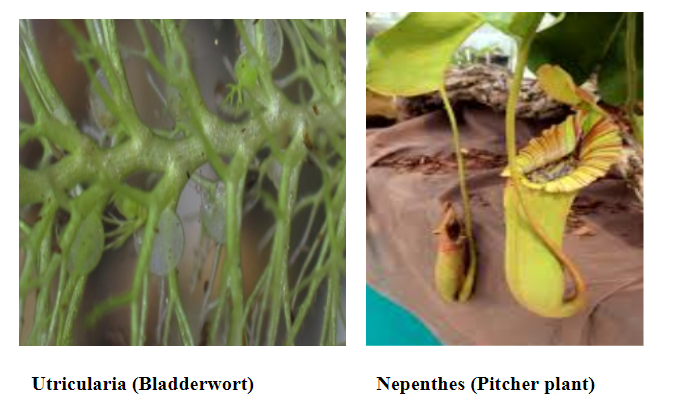
Answer
469.2k+ views
Hint: Insectivorous plants are those plants that obtain their food or nutrition by feeding on insects and other organisms. Utricularia, commonly called as bladderworts are insectivorous plants. Utricularia in its bladders mouth has sensitive bristles or hairs to catch the prey.
Complete answer: Plants which are specialized in trapping insects are popularly known as insectivorous plants. They are very different from normal plants in their mode of nutrition.
They, however, never prey upon humans or large animals.
These are colorful, shiny, possess sweet nectar, and pleasant odor to attract insects. Insectivorous plants of India belong mainly to three families: Droseraceae, Nepenthaceae, and Lentibulariaceae.
Some plants capture and digest insects passively as a sin pitcher plant (nepenthes) or by the movement of certain organs, like closing the leaf traps the moment insects land on them (Venus flytrap).
Additional information: Utricularia, commonly called as bladderworts are the insectivorous plants among the following options, and they belong to the family, Lentibulariaceae.
Utricularia in its bladders mouth has sensitive bristles or hairs. When an insect happens to contact these hairs the door opens, carrying the insect into the bladder along with a little current of water.
The door is shut when water fills the bladder; the enzymes produced by the inner wall of the bladder digest the insect.

Thus, the correct answer is Utricularia
Note: Utricularia or bladderwort has medicinal property.
They are useful against cough, for the dressing of wounds, and as a remedy for urinary diseases. Other insectivorous plants include pitcher plant, venus fly trap, drosera, butterworts, sundew, etc.
Opuntia is a species of cactus belongs to the family Cactaceae, crotalaria, known as rattlepods belongs to Fabaceae, Eicchornia, known as water cyanth or terror of Bengal, belongs to the family pondeteriaceae that spreads all over the water body fast in a short time.
Complete answer: Plants which are specialized in trapping insects are popularly known as insectivorous plants. They are very different from normal plants in their mode of nutrition.
They, however, never prey upon humans or large animals.
These are colorful, shiny, possess sweet nectar, and pleasant odor to attract insects. Insectivorous plants of India belong mainly to three families: Droseraceae, Nepenthaceae, and Lentibulariaceae.
Some plants capture and digest insects passively as a sin pitcher plant (nepenthes) or by the movement of certain organs, like closing the leaf traps the moment insects land on them (Venus flytrap).
Additional information: Utricularia, commonly called as bladderworts are the insectivorous plants among the following options, and they belong to the family, Lentibulariaceae.
Utricularia in its bladders mouth has sensitive bristles or hairs. When an insect happens to contact these hairs the door opens, carrying the insect into the bladder along with a little current of water.
The door is shut when water fills the bladder; the enzymes produced by the inner wall of the bladder digest the insect.

Thus, the correct answer is Utricularia
Note: Utricularia or bladderwort has medicinal property.
They are useful against cough, for the dressing of wounds, and as a remedy for urinary diseases. Other insectivorous plants include pitcher plant, venus fly trap, drosera, butterworts, sundew, etc.
Opuntia is a species of cactus belongs to the family Cactaceae, crotalaria, known as rattlepods belongs to Fabaceae, Eicchornia, known as water cyanth or terror of Bengal, belongs to the family pondeteriaceae that spreads all over the water body fast in a short time.
Recently Updated Pages
When would the stomata be open class 10 biology CBSE

What is the 5R principle class 10 biology CBSE

Can a food chain start from deer class 10 biology CBSE

What is the role of humans in resource development class 10 biology CBSE

Whether the gametes are diploid or haploid Why class 10 biology CBSE

What are the effects of ozone depletion on plants class 10 biology CBSE

Trending doubts
Which are the Top 10 Largest Countries of the World?

Differentiate between homogeneous and heterogeneous class 12 chemistry CBSE

Difference between Prokaryotic cell and Eukaryotic class 11 biology CBSE

Give 10 examples for herbs , shrubs , climbers , creepers

On which part of the tongue most of the taste gets class 11 biology CBSE

Explain sex determination in humans with the help of class 12 biology CBSE

How much time does it take to bleed after eating p class 12 biology CBSE

All animals having feather are a Birds b Bats c Butterflies class 11 biology CBSE

Difference Between Plant Cell and Animal Cell




